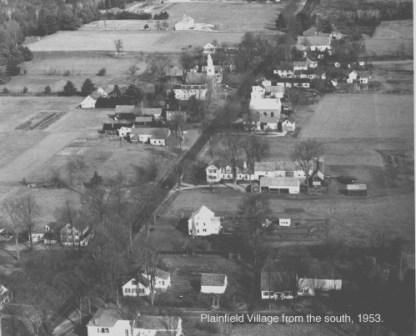A Short History of the Town of Plainfield1
The town of Plainfield was founded in 1761 by a group of 56 proprietors, most from Plainfield, CT, who sought to invest in the New Hampshire Grants when settlement became safe at the end of the French and Indian War. The best agricultural land was in the Connecticut River Valley, and in the summer of 1761, John Stevens, as agent for the others, traveled from Plainfield, CT, to Portsmouth, NH, to petition Royal Governor Benning Wentworth for a land grant. He succeeded and received the town charter, which he brought back to Connecticut. That fall, land along the river was surveyed and lots drawn, and during the next few summers, men came to clear land and build cabins, but returned home to Connecticut for the winter. The first settlers to spend the winter here were Josiah Russell and Littlefield Nash in the winter of 1764-1765. There is at least one family in town, in 2008, that can trace their ancestry back to one of the original proprietors; the Williams family still own land they were granted in 1761.

By 1775, the population of the town had grown to 308. Grist and saw mills had been built, roads were being improved, and controversies were raging about the location of the meeting house. This ultimately led in 1780 to the division of the town into two “parishes”. The western parish included Plainfield village and lands along the river, and the eastern parish was named Meriden. The town continued to grow and prosper, and in 1813, Kimball Union Academy was founded. In the 1820s, the introduction of Merino sheep resulted in a dramatic increase in sheep farming, and provided a profitable cash crop. By 1835 there were sixty-five sheep farms in town, and in 1860 there were 17,000 sheep in Plainfield. Any available land was cleared of trees, and stonewalls were built to contain the sheep. New mills were built along Bloods Brook. The rise of the sheep industry created a period of prosperity, and as a result, many fine new houses and public buildings were built in the 1820-1840 period in both villages. The end of the Civil War, the opening of range lands in the West, and other factors, began to severely depress the market for sheep, and by 1900 there were only 1,100 sheep in town. Land prices dropped significantly, and some farms were abandoned. The population of the town dropped by a third between 1860-1900 as young people sought more opportunities in the West or in the cities. The population continued to decline, and it was not until the late 1970s that Plainfield’s population had regained its 1860 level of 1,620 residents. Most of the farmers who stayed switched from sheep to dairy farming, cattle breeding or poultry. While today there are only two dairy farms left in town, there are a variety of other kinds of successful farming operations.
Plainfield today has a population of about 2,400, and has evolved into a bedroom community for those who work in the Hanover/Lebanon area. We are fortunate that both Plainfield and Meriden Villages retain many of the private and public buildings built in the 18th and 19th centuries that add so much historic character to the town.
1 Excerpted from the Preface to Plainfield Genealogies: Early Plainfield Family Lineages 1640-2005 by Kay MacLeay, as written by Jane Stephenson


